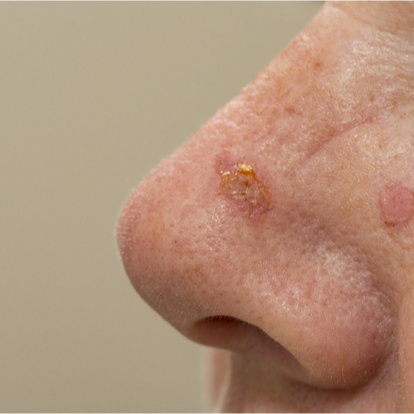 OVERVIEW
OVERVIEW
Also known as solar keratoses, actinic keratoses are precancerous growths on the skin that are caused by long-term UV radiation in the form of chronic sun exposure or tanning bed use. Left untreated, actinic keratoses can progress and evolve into a skin cancer called squamous cell carcinoma.
What are the Symptoms of Actinic Keratoses?
Common findings include:
- Actinic keratoses commonly present as rough or dry patches of skin that are easier to feel than to see.
- Actinic keratoses can be tender or sensitive to the touch.
- Actinic keratoses can be pink, red, skin-colored, tan, or brown.
- Precancers can vary in number, occurring as a solitary lesion (actinic keratosis) or multiple lesions (actinic keratoses).
- The precancers are most commonly found on sun-exposed areas such as the scalp, face, ears, neck, shoulders, forearms, and back of the hands. These precancers can even be found on the lips and are called actinic cheilitis.
What are Risk Factors for Developing Actinic Keratoses?
Common risk factors for developing actinic keratoses include:
- UV radiation in the form of sun exposure or use of tanning beds
- Fair skin
- Increasing age
- Weakened immune system because of illness or certain immune suppressing drugs such as those taken by transplant patients
Protecting your skin from the sun can help reduce your risk for actinic keratoses. Dermatologists recommend avoiding the sun during its peak hours, applying broad spectrum sunscreen (SPF 30 or higher), and wearing sun protective clothing. The use of tanning beds is also strongly discouraged.
Dermatologists recommend routinely checking your skin and scheduling an appointment to evaluate any new, unusual, changing, or symptomatic growths.
How are Actinic Keratoses Diagnosed?
Any new, unusual, changing, or symptomatic growth should prompt a visit to your dermatologist.
At your visit, your dermatologist will evaluate your skin and any lesions or growths of concern. Dermatologists can typically diagnose actinic keratoses with a skin exam. Occasionally, a skin biopsy (a procedure that removes a small sample of the skin) is done to confirm the diagnosis.
Actinic keratoses are evidence of long standing sun damage, thereby increasing your risk for developing additional precancers and also skin cancers.
Treatments for Actinic Keratoses:
When detected early, actinic keratoses are easily treated and cured. Treatment is important because actinic keratoses can progress and evolve into a skin cancer called squamous cell carcinoma.
Common treatment options for actinic keratoses include:
Cryotherapy:
Liquid nitrogen is applied to the precancer or precancers which in turn freezes and destroys the precancerous cells. Cryotherapy is generally used to treat a solitary lesion or a few precancerous lesions.
Photodynamic therapy (PDT):
Photodynamic therapy is a procedure where a light sensitizing topical agent is applied to the affected areas for a period of time. Subsequently, the treated areas are then exposed to a light or laser, generating a reaction that destroys the precancerous cells. This treatment method is typically used for “field” treatment, meaning an entire region such as the face or scalp is treated because numerous or widespread precancerous lesions are noted.
Topical Therapies:
Numerous topical therapies are available to treat precancerous lesions. These include but are not limited to: 5-fluorouracil (5-FU, Efudex, Carac, Fluoroplex, Tolak) used alone or in combination with calcipotriene; imiquimod (Aldara, Zyclara); and diclofenac (Solaraze).
The topical preparation can be applied to a solitary precancerous lesion. More often, topical therapies are applied for “field” treatment of larger areas with widespread actinic keratoses.
During treatment, the treated sites become red, scaly, inflamed, and crusted as the medication eradicates the precancerous cells.
Treating your precancers with a topical preparation requires diligent use of the cream to the affected areas for the prescribed amount of time. Frequently, it requires applying the medication once or twice daily for a period of days to weeks.
If selected as your method of treatment for your actinic keratoses, your dermatologist will provide detailed instructions on how often and how long to use the topical medication.


